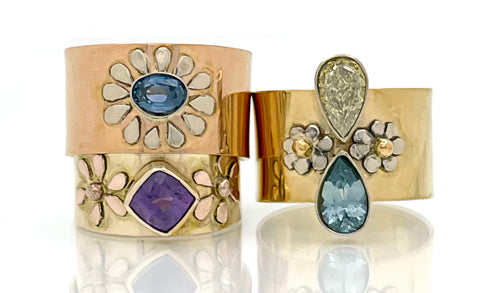Precious gemstones are characterized by pleasing characteristics and a certain level of rarity that make them highly sought after. The result is a stone with a high cost and high demand. But with that high demand comes the attempt to make lesser quality precious gems look better.
The precious 4 have captivated humanity for millennia - diamonds, sapphires, emeralds, and rubies. Each gemstone possesses unique crystal characteristics and beauty, yet they all share common treatments to enhance their appearance. Understanding these treatments and knowing what to watch out for when buying these gems can help ensure that you make a wise investment.
Diamonds

Common Treatments:
1. Laser Drilling: This process removes inclusions by drilling tiny holes into the diamond and dissolving the inclusions with acid. These are barely visible if not invisible to the naked yet, but they can weaken the integrity of the stone.
2. Fracture Filling: This involves filling surface-reaching fractures with a glass-like substance to improve clarity.
3. High-Temperature, High-Pressure (HTHP) Treatment: Used to improve and lighten the color of diamonds, making them more colorless and can gneralkonly be performed on originally high quality diamonds with good clarity.
4. Irradiation: A treatment used to alter the color of a diamond - common color results being blue, green or vivid yellow. The irradiation process alters the stone’s internal molecular arrangement, thereby changing its optical properties/color.
What to Avoid and Watch Out For:
•Certifications: If your buying a diamond over one carat or that seems particularly pricey always buy diamonds that come with a certification from a reputable organization like the Gemological Institute of America (GIA).
•Disclosure: Ensure the seller discloses any treatments. The best way to do this is just ask a lot of questions! Treated diamonds should be significantly less expensive than untreated ones. And ALWAYS ask to be guaranteed that you are buying a natural diamond and not a lab created diamond (unless that is what you are looking for!)
•Clarity Enhancements: Be wary of diamonds that have undergone fracture filling or laser drilling, as these treatments can affect durability and value.
Sapphires
 Common Treatments:
Common Treatments:
1. Heat Treatment: By FAR the most common treatment, it enhances color and clarity. Most sapphires on the market are heat-treated. Unheated sapphires of good clarity can command quite a high price per carat. My personal favorites are Montana Sapphires. They can have stunning blue color with hints of teal and you will pay less per carat that a sapphire from Burma.
2. Diffusion Treatment: Involves adding elements like beryllium to the sapphire during heat treatment to improve color.
3. Fracture Filling: Filling surface fractures with glass or resin to improve clarity.
What to Avoid and Watch Out For:
•Origin: Sapphires from certain locations, like Kashmir or Burma, are more valuable. Verify the origin if the price is high. A certification from a reputable lab can provide this, and more, information
•Disclosure: Ensure the seller discloses all treatments. Untreated loose sapphires in sapphire jewelry command higher prices and are rarer.
•Durability: Watch for stones with significant fracture filling, as this can compromise the sapphire's durability.
Emeralds
 Common Treatments:
Common Treatments:
1. Oil Treatment: The most traditional treatment, it involves filling surface-reaching fractures with oil (for example cedar wood oil) to improve clarity. Some sellers use colored oil - this is frowned upon, so ask that question. There are very few “no oil” emeralds on the market today. If oil is used, and depending on the amount of oil, it may need to be re-oiled in the future to maintain its beauty.
2. Resin Filling: Similar to oil treatment but uses synthetic resins (such as opticon) for a more permanent solution.
3. Heat Treatment: Less common but used to improve color and clarity. I would avoid these if possible.
What to Avoid and Watch Out For:
•Clarity Enhancements: Almost all emeralds are treated with oil to some extent. The type and extent of treatment should always be disclosed.
•Durability: Be cautious with heavily treated emeralds, as the treatments can wear off or affect the stone’s structural integrity. Heavily fracture filled emeralds will be extremely weakened and not last as long.
•Certification: Look for emeralds certified by reputable gemological laboratories, which will detail the treatments used, and the origin. A lab report, if requested, can provide origin information (Columbian emeralds command a higher price) as well as what degree of oil or resin treatment it has had - ranging from no oil, minor oil, moderate oil and so on.
Rubies
 Common Treatments:
Common Treatments:
1. Heat Treatment: By far the most common treatment used to improve color and clarity, heat-treated rubies are very common. I personally don’t work with heated rubies.
2. Lead Glass Filling: Fills fractures and improves transparency. This treatment is less stable and can dramatically defrease the ruby’s value. I would NEVER even consider a Ruby that has had glass filling.
3. Fracture Filling: Similar to lead glass filling but can use other substances like resins or oils.
What to Avoid and Watch Out For:
•Disclosure: Ensure full disclosure of any treatments. Heat-treated rubies are acceptable, but glass-filled rubies are less valuable. A jewelry piece with a completely untreated Ruby commands an incredibly high price per carat in comparison to any treated Ruby.
• Origin: Rubies from Burma (Myanmar) are highly prized. Verify the origin for higher-value rubies and often in a color referred to as “pigeons blood”.
• Durability: Glass-filled rubies are more fragile and require careful handling. These often break or crack during setting and are not a good long term investment.
General Tips for Buying Precious Gemstones
1. Certification: Always seek certified gemstones from reputable gemological labs, especially if the size is over 1 carat or comes with an incredibly high price tag. Certifications provide details about the gemstone's origin, quality, and treatments.
2. Reputable Sellers: Buy from well-established and trustworthy dealers. This reduces the risk of purchasing misrepresented or treated stones.
3. Knowledge: Educate yourself about the specific gemstone you are interested in. Knowing the common treatments and market values will help you make an informed decision, and allow you to ask very specific questions when purchasing.
4. Ask Questions: Don’t hesitate to ask the seller detailed questions about the gemstone’s treatments, origin, and certification. This information MUST be disclosed.
Conclusion
Diamonds, sapphires, emeralds, and rubies each offer rarity, unparalleled beauty and unique characteristics. By understanding their common treatments and what to look for when purchasing, you can ensure that your gemstone is both beautiful, long lasting and a good investment. Whether you're a seasoned collector or a first-time buyer, informed decisions are the key to enjoying these timeless treasures for years to come.
